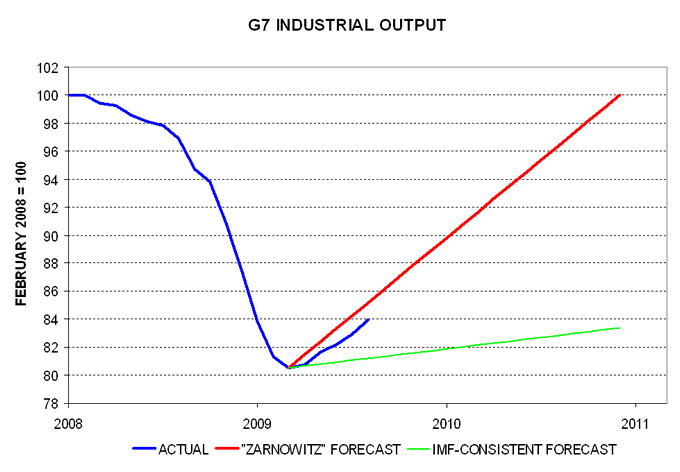Global recovery: IMF vs Zarnowitz revisited
Posts in early and mid April suggested that G7 industrial output would recover more strongly than forecast by the IMF and consensus. This was based partly on the "Zarnowitz rule" that "deep recessions are almost always followed by steep recoveries".
US business cycle history provides some guidance about the possible speed of a Zarnowitz-style recovery. There have been eight falls in US industrial output of 13% or more since 1890. In six of the eight cases, output regained its prior peak level within 21 months of the trough. The exceptions were the recoveries after the 1929-32 slump – when output plunged by 54% – and the 1944-46 recession, when the economy needed to restructure away from armaments production.
In the recent recession G7 industrial output fell by 19% over 13 months to a trough in March 2009. (The March trough had been signalled by monetary data in late 2008.) Based on the US evidence, discounting the post 1932 and 1946 recoveries, output could regain its peak level within 21 months, i.e. by December 2010. This would imply annualised growth of about 13% during the recovery.
The chart compares the actual rise in output since the March trough with this "Zarnowitz" forecast and an alternative 2% growth scenario. 2% is the maximum likely to be consistent with the IMF's latest published forecast of GDP expansion in advanced economies of only 0.6% in 2010. The last data point, for August, is an estimate based on US data released yesterday and a METI survey forecast for Japanese output.
Output is tracking slightly below the Zarnowitz path but is recovering much faster than forecast by the IMF and consensus. Based on the August estimate, the growth rate in the five months since the March trough has been 10% annualised.
Leading indicators suggest an acceleraton into the autumn, possibly closing the gap with the Zarnowitz forecast. For example, the OECD's G7 leading index, which is designed to predict industrial output, rose by 18% annualised in the three months to July.
Investors are debating whether the pick-up will be sustained into 2010. With the boost from the stocks cycle still at an early stage and financial market conditions improving, an optimistic view remains warranted but this requires confirmation over coming months from a stabilisation of labour markets and continued monetary expansion.

Reader Comments